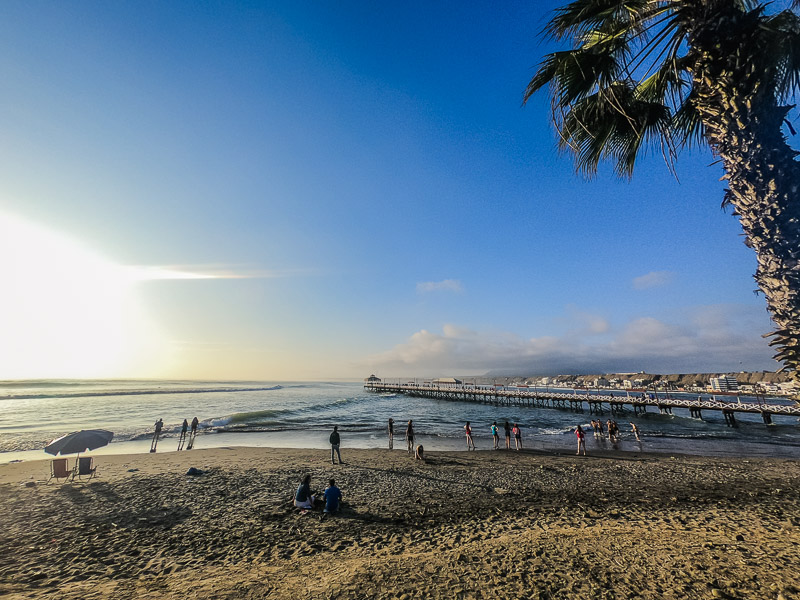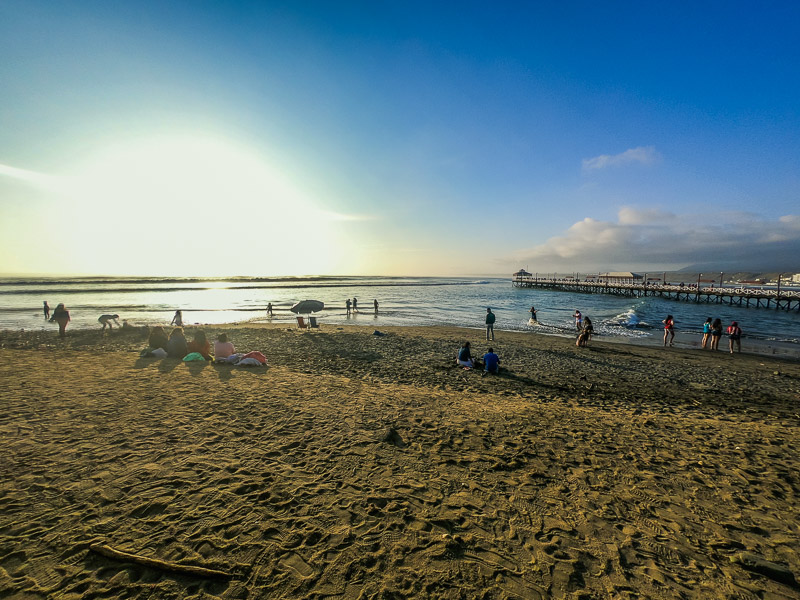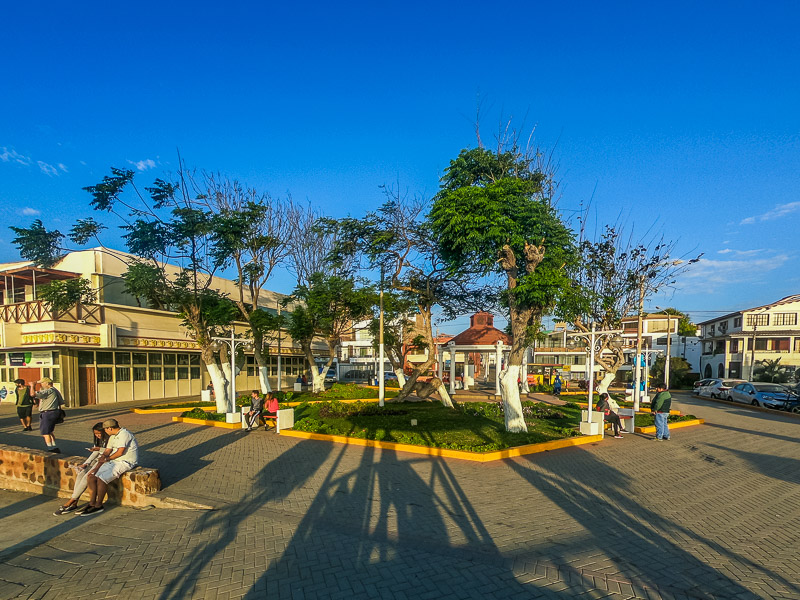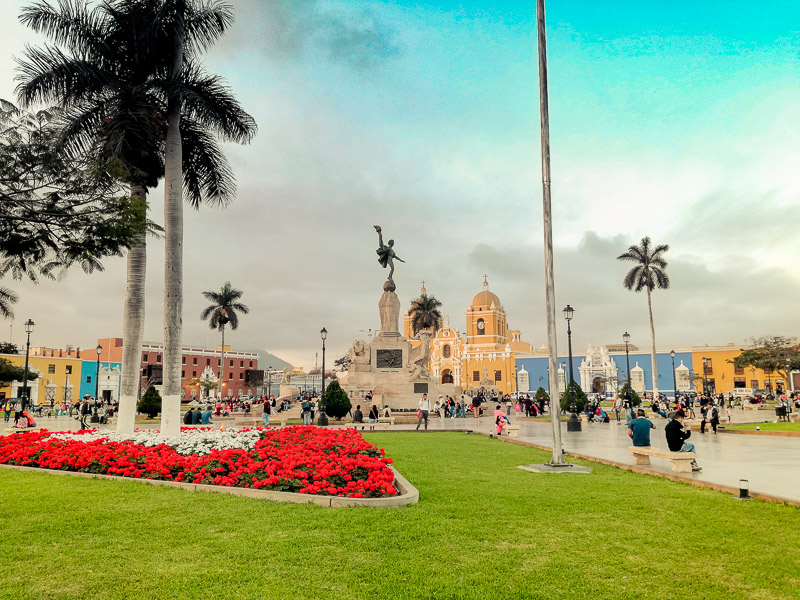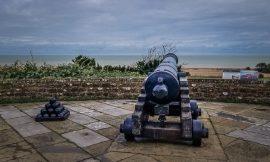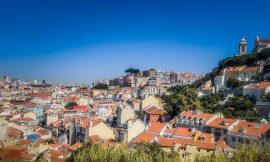Coming from Chachapoyas, the bus journey takes 13 hours stopping in Chiclayo first. We took the overnight trip with Movil Bus leaving Chachapoyas at 7.30 PM and arriving in Trujillo by 8.30 AM. It’s worth getting the VIP option where the seats recline 160 degrees to get some sleep. The first part of the journey is along the winding roads that descend the Andes, so keep that in mind if you get motion sickness. The bus terminal in Trujillo is quite big and somewhat modern. Upon exiting we came across a stall that was selling tours. We got some info but before buying we went to look at the bus schedules since we were leaving for Huaraz that night. Since we had a great experience with Movil Bus, we went with that company again for an overnight bus to Huaraz leaving at 10 PM. We left our bags with the bus company and then went back to the tour sales rep to purchase the tour. The tour was for transportation to Huaca del Sol y de la Luna, Huaca Arco Iris, Chan Chan, and the beach with a guide. We knew it was possible to get public transport/taxi between the sites but for 25 PEN1, this tour was more convenient and guided which is always best with archaeological sites. The pick up was scheduled for 10 AM which gave us some time to grab breakfast before heading out.
Huaca Del Sol Y De La Luna
There are two Huacas south of Trujillo, Huaca del Sol and Huaca de la Luna. They’re close to each other but only Huaca de la Luna is open to the public as the other one is still being excavated. Before heading to the site, you have to purchase tickets from the Museum entrance which is a short 5-minute drive from the archaeological site. Entrance tickets for the archaeological site (10 PEN) and the museum (5 PEN) have to be purchased here. If you’re a student then it’s 5 PEN and 3 PEN. The museum is fairly small but very modern and has many of the artifacts found in the Huacas. The information panels were both in Spanish and English so you can roam freely to learn about the Moche people who built the Huacas. We were given about 30-45 minutes to go through the museum before heading to the site itself. In Huaca de la Luna there are remains of a wall which stretches to the base of the mountain. There is a legend about why the wall is connected with the mountain. In a time before the Huaca was built, the Mochica people worked the land and two young men found a small colored snake whilst digging. The colors intrigued them so they took the snake home and raised it like a pet. As days went by, the snake quickly grew so the young men became scared and threw it in a river. The snake continued to grow and when it became huge, it went into the town and destroyed anything in its path. The people fled to take refuge at the base of the mountain but the snake managed to track them down. As the snake lept to devour the people, the mountain cracked open so the snake fell inside it. There’s a crack in the mountain which serves as ‘evidence’ for this legend. The mountain then closed saving the Mochica people. In an act of gratitude to the Mochica god – Aia Paec – they constructed the Huaca connected to the mountain.
Entering the site, the tour starts at what is known as the sacrificial hall. Archaeologists discovered human remains in a room at the far end of this hall. They believe these to be human sacrifices of warriors between the ages of 18 and 25. It is believed that that two warriors would battle each other with a club and shield in the desert, far away from the temple. The Mochica warriors wore a headdress and the winner of the battle was the warrior that managed to knock it off their opponent. The losing warrior was stripped naked, and a noose tied around his neck from which he was taken back to the temple. The priests were then in charge of preparing him for sacrifice in one of the rooms in the sacrificial hall. He was given a hallucinogenic drink – San Pedro – which cleansed his blood and essentially sedated him in preparation for his death. He was given this drink for two weeks after which he was sacrificed by cutting his neck and his blood poured into a cup. This cup was then taken to the high priest at the top of the temple who would drink half, and pour the other half on the ground as a tribute to the earth. The sacrifices were only carried out in times of crisis due to natural disasters. Since the Mochica’s god was represented by nature, they believed their god was angry with them and carried out sacrifices to appease them.




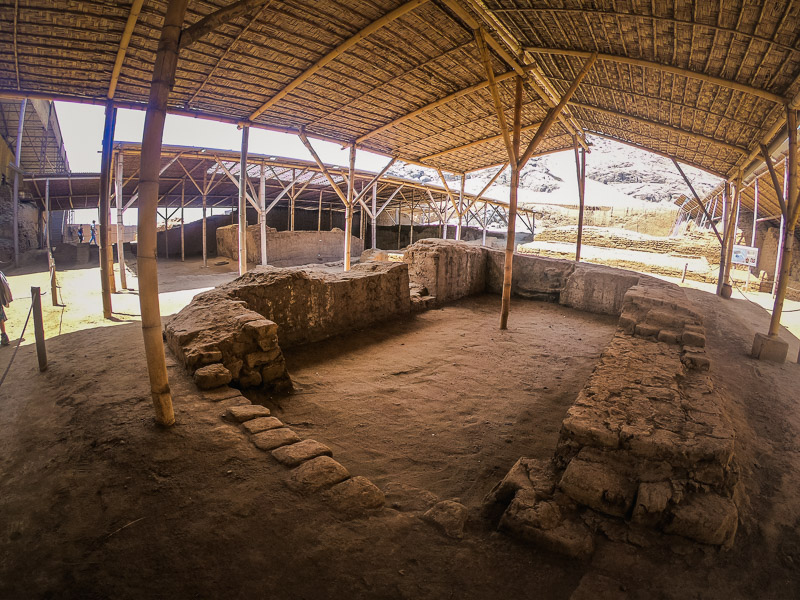

The Mochica built their temples in cycles. They believed every 80-100 years represented a life cycle where they buried the past and built a new one over it. They built their temples in this way, and in that period, one or two priests would have passed away. They buried them in the temple and sealed it off with clay-like bricks. Rather than burying the old temple with soil, they used bricks as a anti-seismic feature since they were going to build on top of it. Before burying the old temple, they would also coat the walls to protect its decor. Huaca de la Luna is made up of 5 levels. The highest level has eroded since it was the most exposed. However, archaeologists have excavated the site to reveal the lower levels which have been well preserved since they’d been buried. The walls are 100% original and have not been restored in any way. These walls have been decorated with the image of the Mochica god. The eyes are of an owl which represents air. The teeth are of a feline animal which represents the land. The hair is tentacle-like of an octopus which represents the sea. The pattern of the border represents a manta ray which again refers to the sea since the Mochica were mainly fishermen. There are also images of a blackfish around the god which is of a river freshwater fish. This is to show the Mochica not only fished in the sea, but also the rivers.
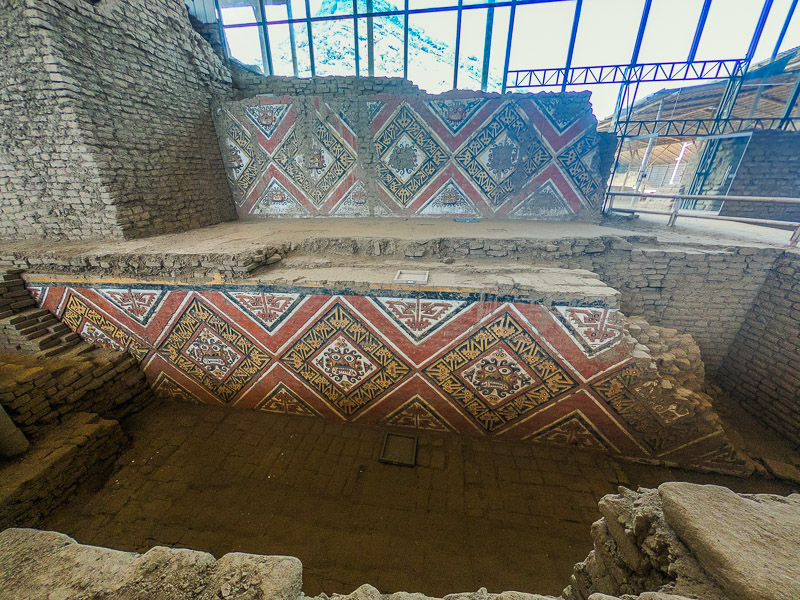

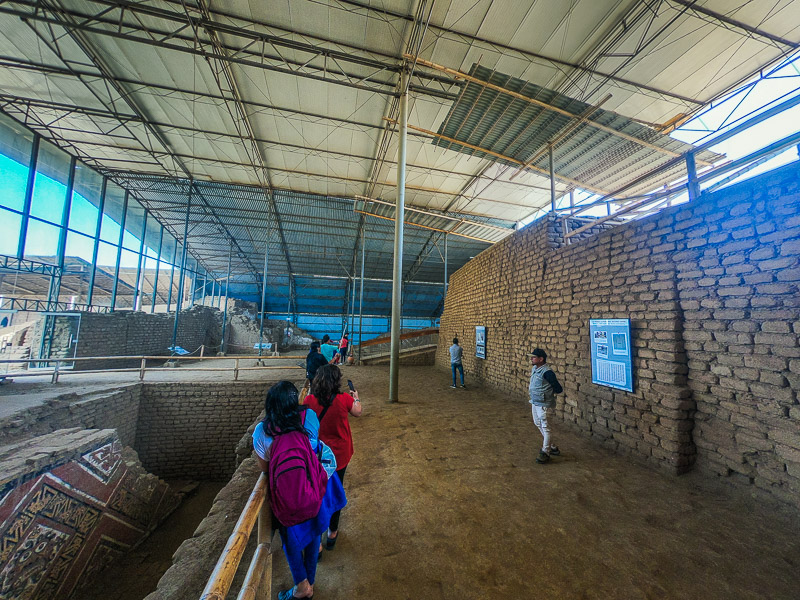





Arriving at the fifth level, we can see the alter from where the high priest drank the sacrificed warrior’s blood. The source of this theory comes from carvings found on Mochica ceramics showing a naked warrior and a priest drinking from a cup at an alter. From the fifth floor, we can also see an area known as the colonial square. It is named like this because it shows how the Spanish have raided the temple for its treasures and in doing so, have destroyed the structure effectively erasing a part of the Mochica culture. The fifth floor dates back to 600-650 AD where there was a major natural disaster in the area. This fact connects to a theory of what happened to the Mochica. It is believed that despite sacrifices being made by the Mochica, the natural disaster did not end. So the Mochica people lost faith and some decided to move away, closer to the sea. These people formed a new civilization known as Chimu.
The tour finishes in the great plaza which used to serve as the main entrance to the temple. From here we can see the multiple levels of the temple. Each mural is decorated and there appear to be six levels rather than five but this is because the first level is split into two. Every subsequent level was then built on top of the previous structure. The lower mural is decorated with the losing warriors or warriors fighting. The next level is decorated with warriors holding hands. This shows a sacrificial ceremony also consisted of dance and singing. Above that is a decoration of what is known as the decapitating spider. It shows an image of a spider holding a knife and a head. This showcases the ritual they carried out. Next, we see an image of a feline animal with two heads. The two heads represent duality. Finally, we see an image of a serpent which sheds its skin to represent how the Mochica built their temples. To the left of the main wall, there is what the archaeologists have called ‘The Mural of Myths’. It has carvings of the many stories about the Mochica.
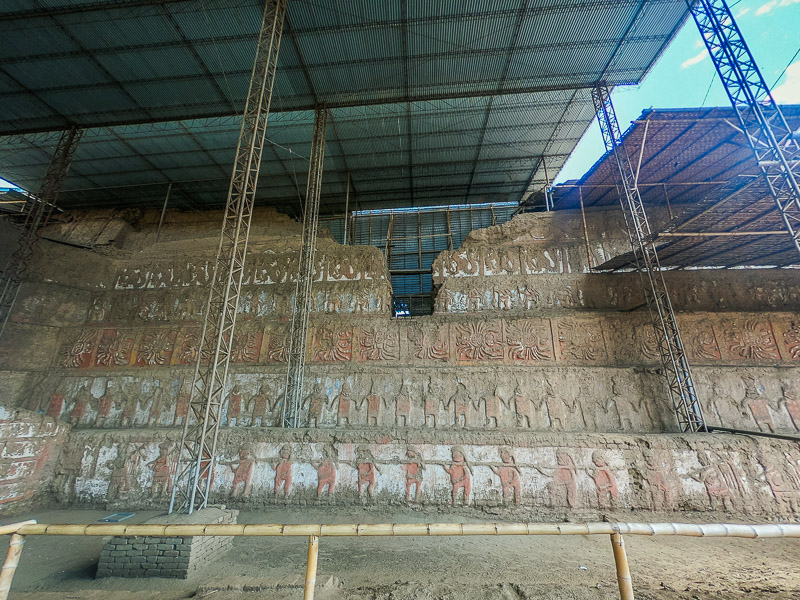

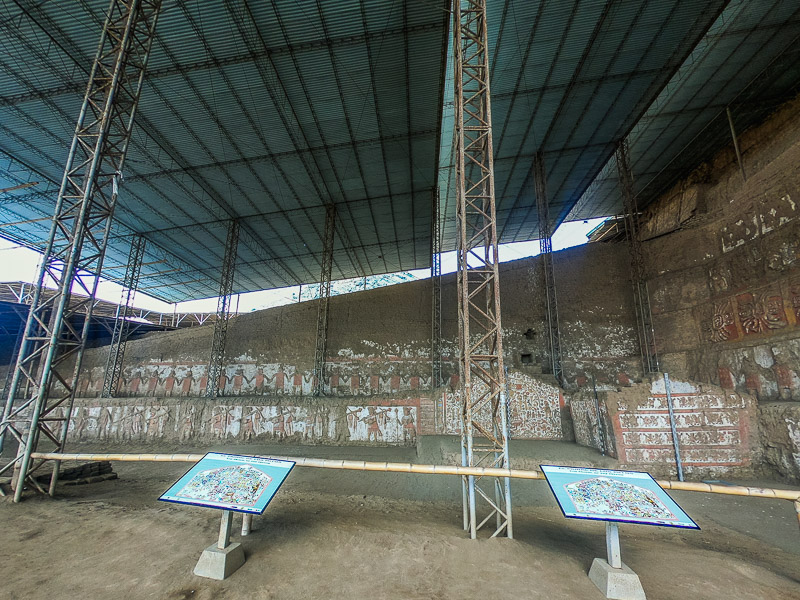



Huaca Arco Iris
In the afternoon we continued to the north of Trujillo to Huaca Arco Iris. This site belonged to the Chimu culture which dates between 900 and 1470 AD. This civilization is found only on the northern coast of Peru. This Huaca belonged to Chan Chan which was the capital of the Chimu civilization. In it’s prime, Chan Chan stretched across 20 KM squared but is now reduced to 14 square KM. The internal walls have carvings and in some areas, you can see a yellow color. This gave the Huaca its first name – The Yellow Wall. Originally, all the walls had carvings but it has eroded on the outer walls and only remains in the inner walls. After the archaeologists progressed with their excavations, they revealed a carving which looks like two dragons breathing fire. The Huaca was then known as Huaca of the Dragon. Now it is known as Huaca Arco Iris (Rainbow) due to a rainbow shape above the ‘dragons’. The rainbow is symbolic to the Chimu since it represents rain which was scarce in the region. Other parts of the carving show fisherman, an altar, dancing warriors, and the carving of the ‘fire breathing dragons’ are actually sea horses holding an egg – one male and one female – which represents duality. Therefore, this Huaca was a temple for ceremonies and a place where people came to give offerings. Walking up the temple we can see deep holes on the sides which were used as deposits for offerings. Archaeologists found seeds, wood carvings, and ceramics. There are fourteen of these deposits. This reflects the lunar calendar since the Chimu worshipped the moon. The moon was the most important to the Chimu for three reasons; the moon could be seen in the day and night, the moon blocks the sun in an eclipse, and the moon controls the tide.
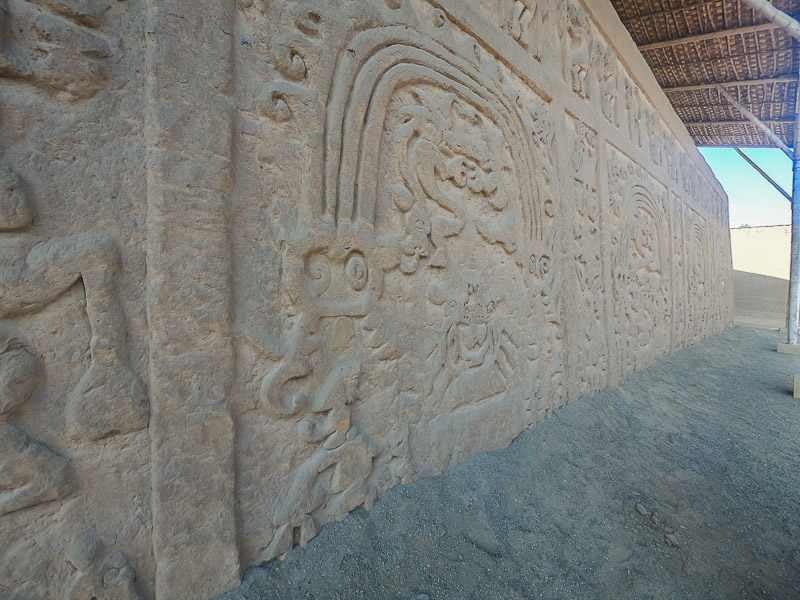

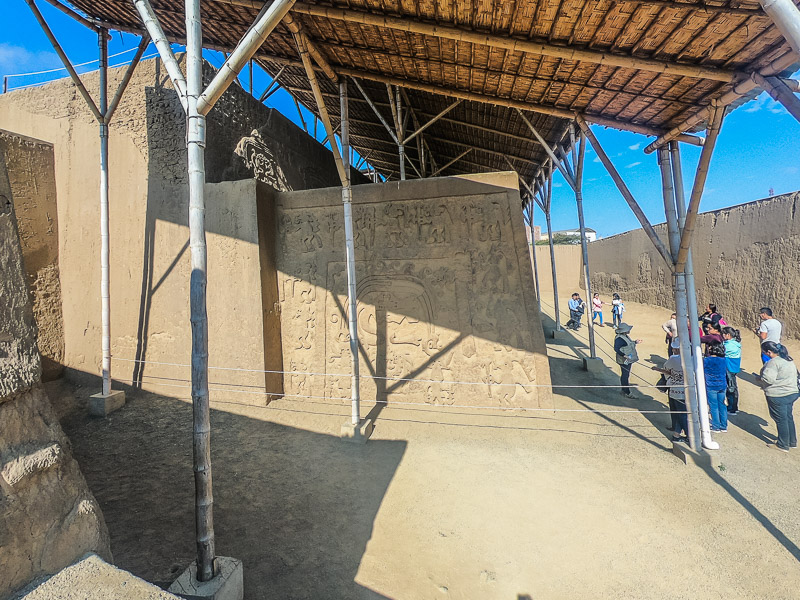

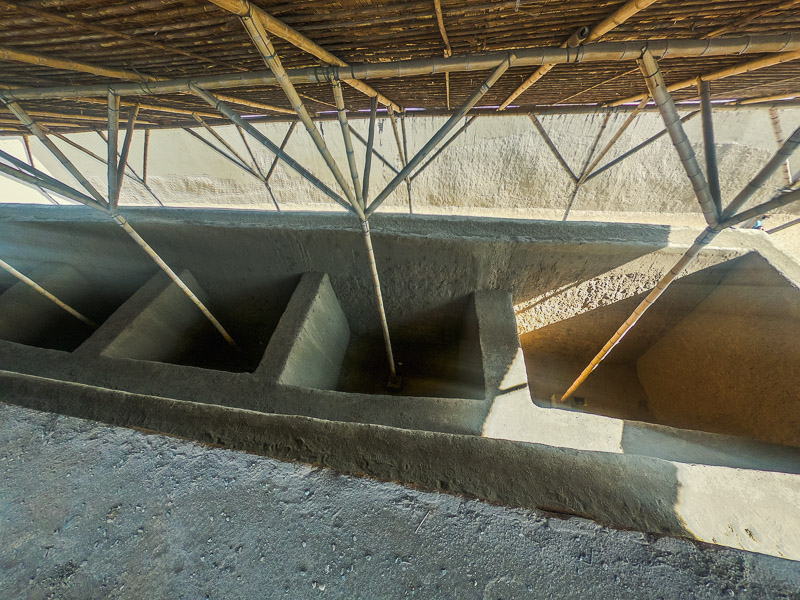

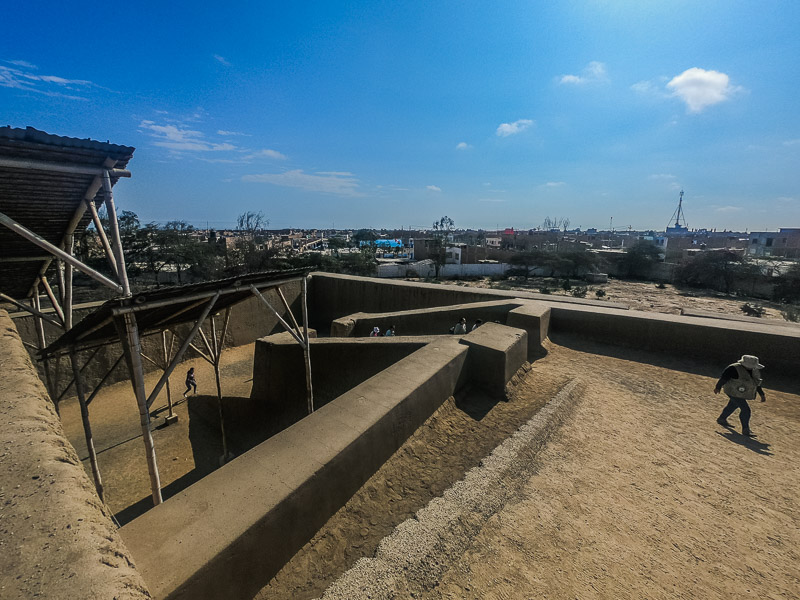

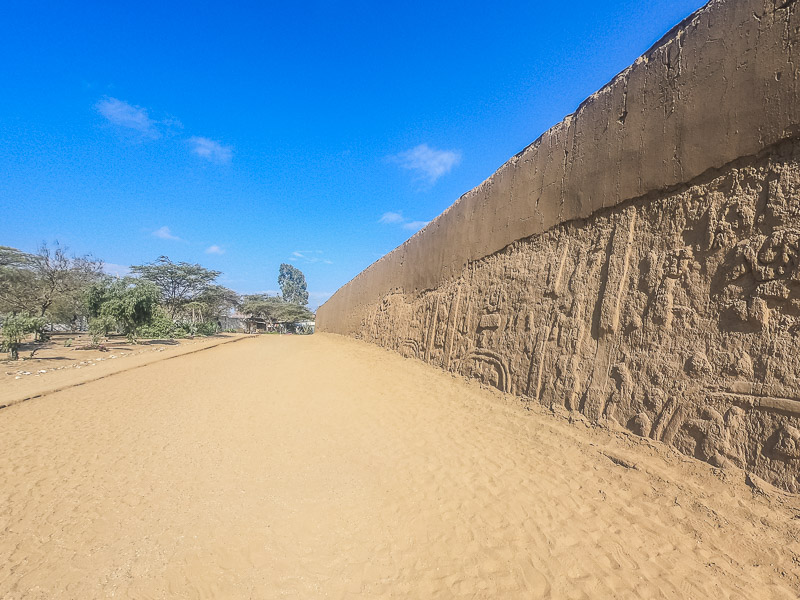

Next, the tour group is taken into the city for lunch. The tourist restaurant lunch spot was a block away from the Plaza de Armas. Now, I’ve never been a fan of tourist restaurants since they’re normally not authentic and tailored for tourists. After taking a look at the ‘tourist menu’ and the dishes going around, my hypothesis was valid plus the prices were a little too high for my liking. So we let the guide know we were gonna walk around and he just told us to be back in an hour. We noticed that even they don’t eat there and just leave the tourists there whilst they go somewhere else. After walking around we found a nice spot around the corner. The ‘Almuerzos’ – which are essentially lunch set menus including a drink – were only 9 PEN and very tasty.
Chan Chan
The last archaeological site of the tour was the ruins of Chan Chan. Chan Chan was the name of the capital city of the Chimu people, so these ruins were of the palace of the chief Chimu. It was like a fortified walled citadel with a single entrance/exit. The outer walls were of a trapezoid shape which served as an anti-seismic design measuring between 10 and 12 meters high. The citadel is like a huge maze with its internal walls measuring 3-4 meters high. To the left of the entrance was the route taken by workers who delivered food and resources for the palace. To the right was the route taken by important guests from neighboring civilizations which led to the main ceremonial plaza. The guests would bring offerings and these would be placed on a platform in the middle of the ceremonial plaza. The sides of the plaza were lined with benches which is where the guests would have sat for the ceremony. The ramp leading to the front is where the chief Chimu would have sat and addressed the public from. The plaza was designed in a way to project sound from one end to the other so the chief could be heard from everywhere. The walls have carvings split into three sections. The middle and biggest section looks like waves to represent the sea. The top section is clear to represent the sky, and the bottom section is lined with animals to represent the land. The reason why it is shown in this order is that the Chimu lived by the sea. So if you stand at the beach, you see the ground at the bottom, the sea in the middle, and the sky at the top.
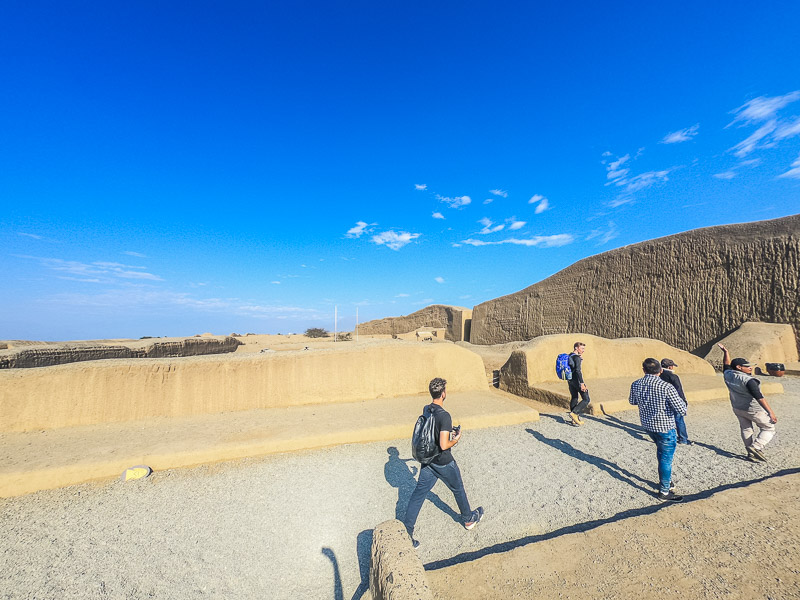

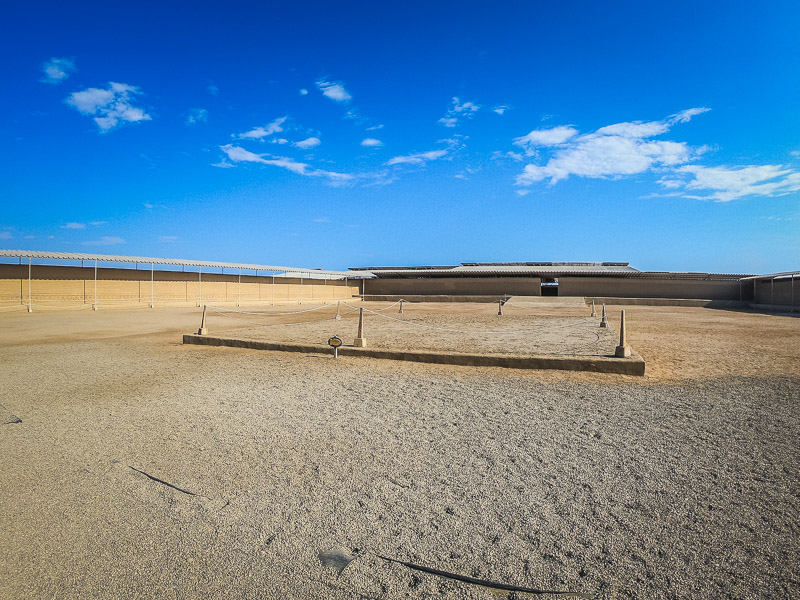

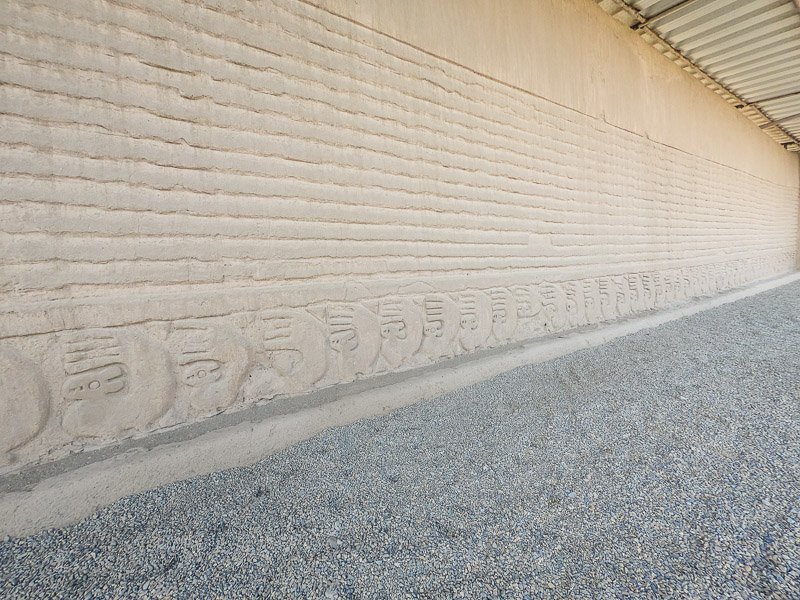

The walls along the walkways are lined with more carvings. On one side the carvings look like steps that go up and down repeatedly throughout the length of the hallway. These represent the tide. The wall is split by a knee height perpendicular wall. There are carvings of fishes stretching from the northern side which are shown facing the middle. Likewise, the fishes from the south also face the middle. Therefore on one side, the fishes are traveling from north to south to represent the warm current that goes from Ecuador to Peru. The other side shows them traveling from south to north to represent the cold current that comes from Chile. On the opposite side, the parallel wall is carved into rows of rhombuses. This represents the fishermen’s nets. These carvings are present throughout the complex. At the end of the path was another smaller plaza which is were performers got ready before heading into the main plaza for the ceremony.
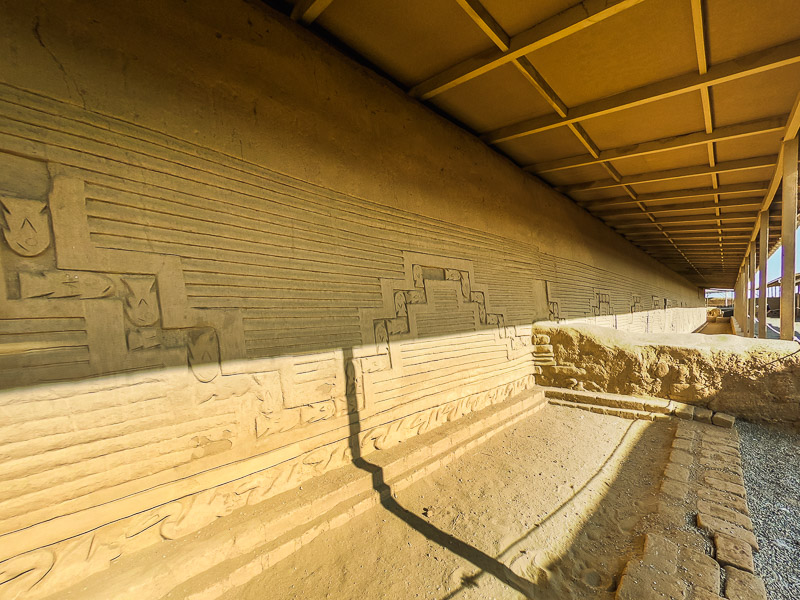

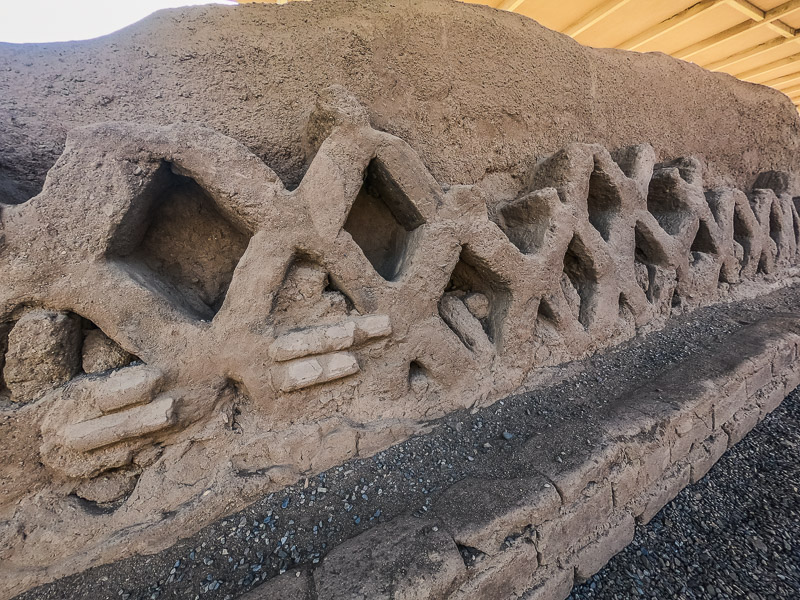

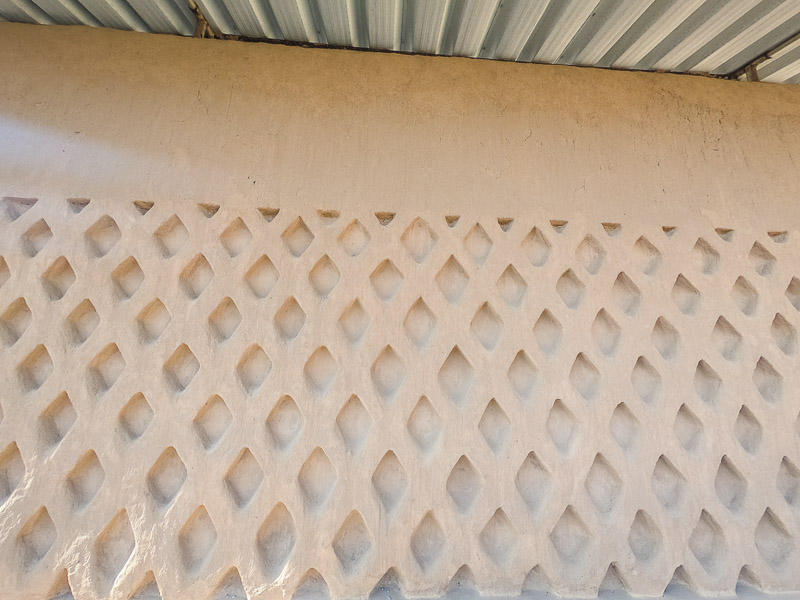



Walking past this into one of the structures, we arrive at the Hall of Attendant Hearings. This was an administrative building and was built like a labyrinth. It was built this way to make it difficult for intruders to find their way around. They had a system were they used carvings of pelicans to mark the entrance/exits of rooms which only the workers would have known how to use. The area was used to store ‘tributes’ from the people to the Chief. These were like taxes but since there was no money, it would be in the form of produce. So this vast area served as storage which needed to keep produce fresh. This is why the walls have rhombus-shaped holes to allow air to flow through. The rooms also have U-shaped compartments with a window where wood carvings were found. These wood carvings were probably used by the Chimu as a symbol of protection.
Next, we arrive at another big plaza. Unlike the plaza at the entrance, this one was not for visitors but private functions. Surrounding this plaza, there are many small houses where human remains were found. It is believed that when a Chief died, his wives would also have to die and be buried with him to follow him into the next life. As we go further into the complex, we arrive at what would have been a large reservoir. Although it is dry now, this reservoir would have been 4 meters deep filled with freshwater. The water would have been diverted from the river to fill up the reservoir. At night, the moon would reflect on the water and the place was used for ceremonies and sacrifices. In contrast to the Moche sacrifices, the Chimu sacrificed children between 12-13 years old as a tribute of purity. These reservoirs were also the downfall of the Chimu to the Incas. At around 1470, the Incas came to conquer and fought with the Chimu for many years. The Chimus were great warriors and the Incas could not break through the fortifications. However, the Incas noticed the water fed into the walled citadel. So they cut off the water supply which left the Chimu with no option than to surrender and join the Incan empire of Tawantinsuyu.


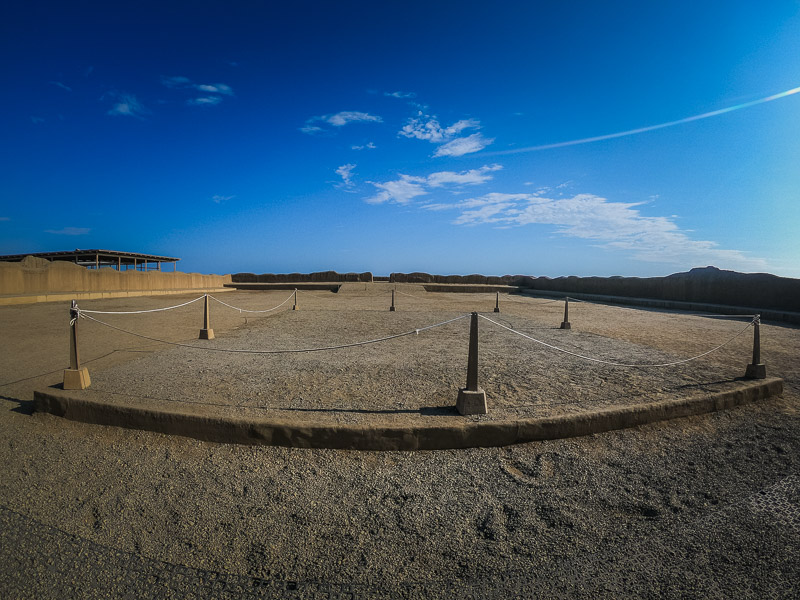

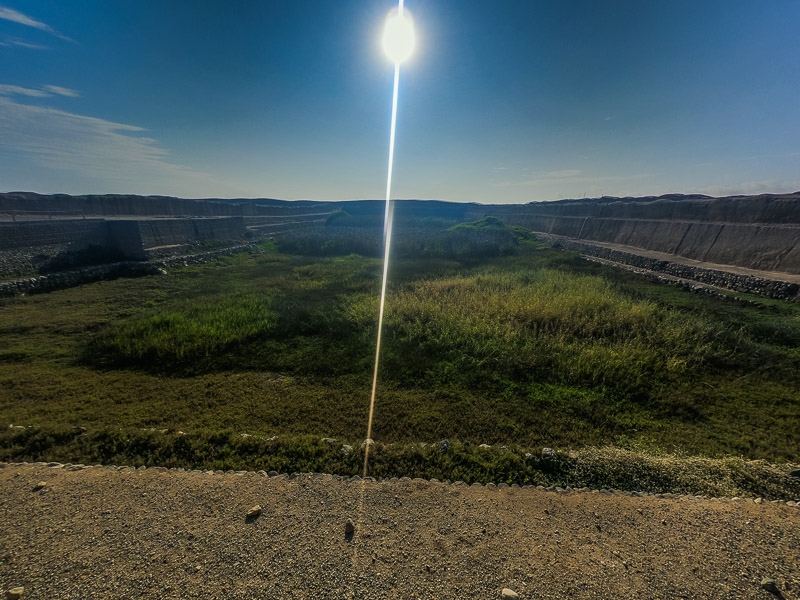



The final stop in the palace is the burial plaza of the Chief. The Chief’s body was prepped and put in the middle for five days for the people to pay their respects. The body was then taken up the ramp to the tomb which was surrounded by the small houses where his wives would be buried. Once the Chief was buried, his successor was not allowed to use the palace. He would have to build his own palace which is why there are ten palaces in Chan Chan, of which only this one has been excavated.
Huanchaco Beach
Lorem ipsum dolor sit amet, consectetur adipiscing elit. Ut elit tellus, luctus nec ullamcorper mattis, pulvinar After finishing up at Chan Chan, we headed for the beach at Huanchaco at around 4.45 PM. This beach is about a 20-minute drive north of Chan Chan. It has a nice walkway, a pier and it’s a great spot to catch the sunset. However, we were only had until 5.30 PM before the tour headed back to Trujillo city center. We were back in the Plaza de Armas by 6 PM. From here we decided to check out one of the shopping plazas. It was a short 15-minute taxi ride (6 PEN) to Real Plaza which was close to the bus terminal. After walking around for a bit we found a cinema and decided to catch a movie before heading to the bus terminal for our next destination. leo.
